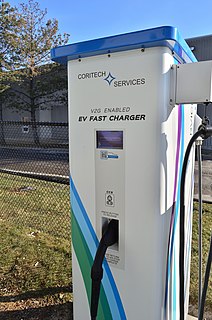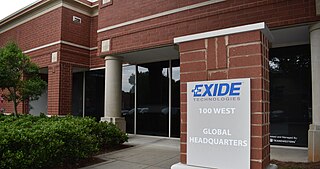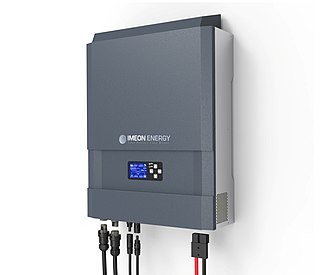Distributed generation, also distributed energy, on-site generation (OSG), or district/decentralized energy, is electrical generation and storage performed by a variety of small, grid-connected or distribution system-connected devices referred to as distributed energy resources (DER).

Grid energy storage is a collection of methods used for energy storage on a large scale within an electrical power grid. Electrical energy is stored during times when electricity is plentiful and inexpensive or when demand is low, and later returned to the grid when demand is high, and electricity prices tend to be higher.

Vehicle-to-grid (V2G) describes a system in which plug-in electric vehicles (PEV), such as battery electric vehicles (BEV), plug-in hybrids (PHEV) or hydrogen fuel cell electric vehicles (FCEV), communicate with the power grid to sell demand response services by either returning electricity to the grid or by throttling their charging rate. V2G storage capabilities can enable EVs to store and discharge electricity generated from renewable energy sources such as solar and wind, with output that fluctuates depending on weather and time of day.

A smart meter is an electronic device that records information such as consumption of electric energy, voltage levels, current, and power factor. Smart meters communicate the information to the consumer for greater clarity of consumption behavior, and electricity suppliers for system monitoring and customer billing. Smart meters typically record energy near real-time, and report regularly, short intervals throughout the day. Smart meters enable two-way communication between the meter and the central system. Such an advanced metering infrastructure (AMI) differs from automatic meter reading (AMR) in that it enables two-way communication between the meter and the supplier. Communications from the meter to the network may be wireless, or via fixed wired connections such as power line carrier (PLC). Wireless communication options in common use include cellular communications, Wi-Fi, wireless ad hoc networks over Wi-Fi, wireless mesh networks, low power long-range wireless (LoRa), Wize ZigBee, and Wi-SUN.

Exide was originally a brand name for batteries produced by The Electric Storage Battery Company and later became Exide Corporation doing business as Exide Technologies, an American multinational lead-acid batteries manufacturing company. It manufactures automotive batteries and industrial batteries. It is based in Milton, Georgia, United States.

A123 Systems, LLC, is an American company operating as subsidiary of the multinational Wanxiang Group Holdings. A123 systems is a developer and manufacturer of lithium iron phosphate batteries and energy storage systems.
Founded in 2001, the American Council on Renewable Energy (ACORE) is a member-based, 501(c)(3) national non-profit organization that unites finance, policy and technology to accelerate the transition to a renewable energy economy.

A smart grid is an electrical grid which includes a variety of operation and energy measures including:
GridPoint is a cleantech company that provides energy management and sustainability services to enterprises and government agencies, such as electric utilities.
UltraBattery is a hybrid energy storage device invented by Australia's Commonwealth Scientific and Industrial Research Organisation (CSIRO). UltraBattery combines ultracapacitor technology with lead-acid battery technology in a single cell with a common electrolyte.
New Energy for America was a plan led by Barack Obama and Joe Biden beginning in 2008 to invest in renewable energy sources, reduce reliance on foreign oil, address global warming issues, and create jobs for Americans. The main objective for the New Energy for America plan was to implement clean energy sources in the United States in order to switch from nonrenewable resources to renewable resources. The plan led by the Obama Administration aimed to implement short-term solutions to provide immediate relief from pain at the pump, and mid- to- long term solutions to provide a New Energy for America plan. The goals of the clean energy plan hoped to: invest in renewable technologies that will boost domestic manufacturing and increase homegrown energy, invest in training for workers of the clean technologies, strengthen the middle class, and help the economy.
ARPA-E, or Advanced Research Projects Agency–Energy is a United States government agency tasked with promoting and funding research and development of advanced energy technologies. It is modeled after the Defense Advanced Research Projects Agency (DARPA).

CODA Automotive Inc. was a privately held American company headquartered in Los Angeles, California. The company designed and assembled lithium-iron phosphate (LiFePO4) battery systems for automotive and power storage utility applications, and electric cars. Miles Automotive partnered with Hafei and Qingyuan Electric Vehicle to establish Coda Automotive as an affiliate company. The name CODA comes from the musical term for the concluding passage of a piece of music. CODA Automotive has said that it chose the name because its electric vehicle technology represents an end for combustion engine vehicles, and the start of the electric vehicle era.
Support for the smart grid in the United States became federal policy with passage of the Energy Independence and Security Act of 2007. The law set out $100 million in funding per fiscal year from 2008 to 2012, established a matching program to states, utilities and consumers to build smart grid capabilities, and created a Grid Modernization Commission to assess the benefits of demand response and to recommend needed protocol standards. The law also directed the National Institute of Standards and Technology to develop smart grid standards, which the Federal Energy Regulatory Commission (FERC) would then promulgate through official rulemakings.
Fluidic Energy is a corporation based in Scottsdale, Arizona that develops metal–air rechargeable batteries. The company sells systems for energy storage applications from rural electrification to critical backup power and has strong ties throughout the US, Latin America, Asia, and Africa. In March 2015 the Company signed a deal with Caterpillar, which included an equity investment in Fluidic Energy as well as a commercial agreement to collaborate in the microgrid and telecommunications markets. Over the following year, the company announced two separate MOUs for some of the largest renewable-energy rural electrification projects of their kind. The Company is dedicating its operations to “paving the path for the smart, sustainable grid of the future.”
The term Smart Grid describes a next-generation electric power system that is classified by the increased use of communication and information technology in the generation, delivery, and consumption of electrical energy. For individual consumers, smart grid technology offers more control over electricity consumption. Typically, the goal is greater overall energy efficiency.
The University of Kansas Sustainable Automotive Energy Infrastructure Initiative, or more commonly referred to as the KU Ecohawks is an ongoing project that works to promote sustainability in the automotive sector. Founded during the beginning of the Automotive industry crisis of 2008–2010 in the U.S., the group recycles old vehicles to run on community wastes and renewables, especially on the University of Kansas campus and not rely on conventional fossil fuel sources that pollute the local and global environment.

China is the world's largest consumer of electricity, and its demand is expected to double by the next decade, and triple by 2035. In 2010, 70 percent of the country's electricity generation came from coal-fired power plants, but the Chinese government is investing heavily in renewable energy technologies. As of 2013, 21 percent of China's electricity generation comes from renewable sources. This represents only 9 percent of overall primary energy consumption in the country. China's latest goal is to increase renewable energy to 9.5 percent of overall primary energy use by 2015. To implement China's new clean energy capacity into the national power grid, and to improve the reliability of the country's existing infrastructure, requires significant upgrades and ultimately, a smart grid.

An intelligent hybrid inverter or smart grid inverter is a solar power inverter which also connects to battery storage.
EnerNOC, is the largest provider of demand response worldwide, serving a capacity of 6GW across 8,000 customers worldwide, and a leading provider of energy management advisory and technology services and solutions for commercial, institutional, and industrial customers, as well as electric power grid operators and utilities. In addition to demand response, Enel X's solutions offerings include energy procurement advisory services, utility bill management solutions, demand-side management solutions, energy management software and services, and intelligent energy storage and microgrid solutions. In August 2017, EnerNOC was acquired by the Enel Group.








